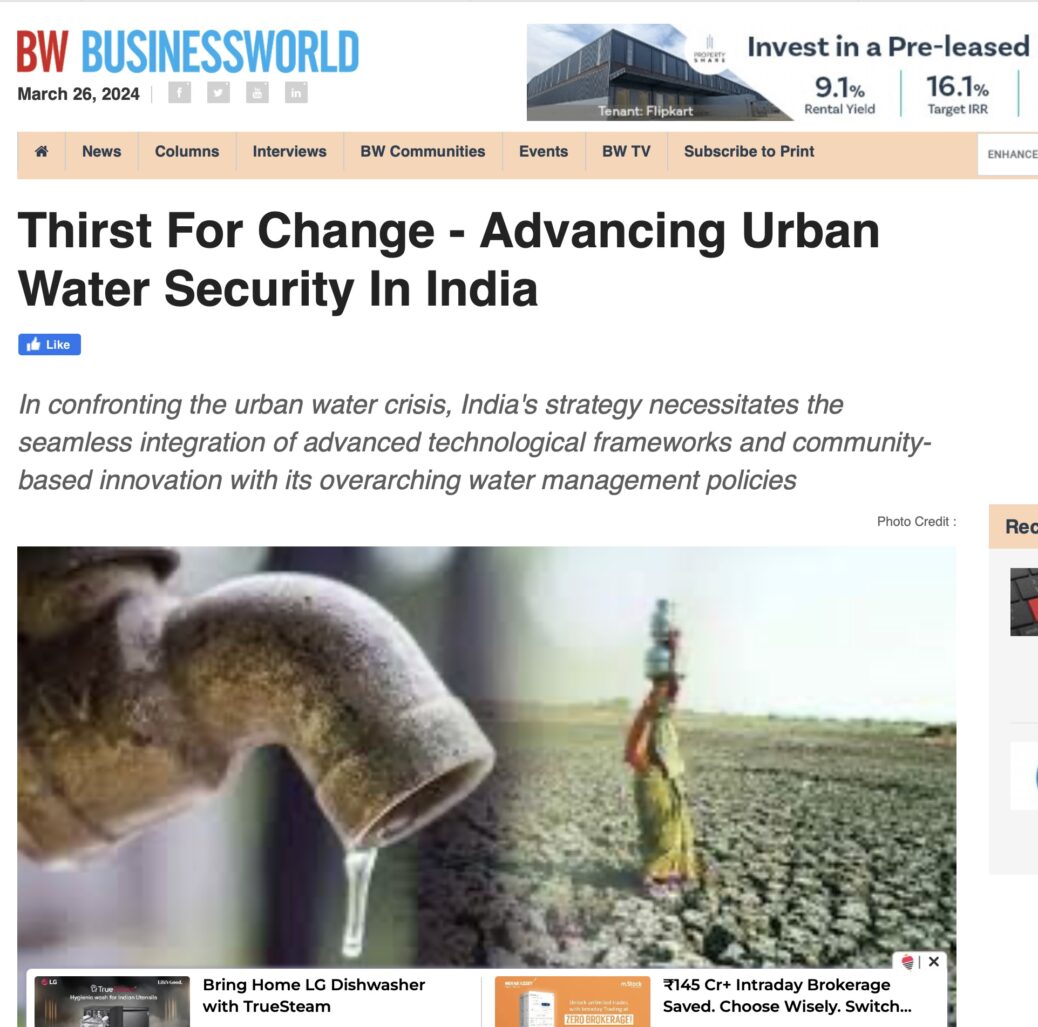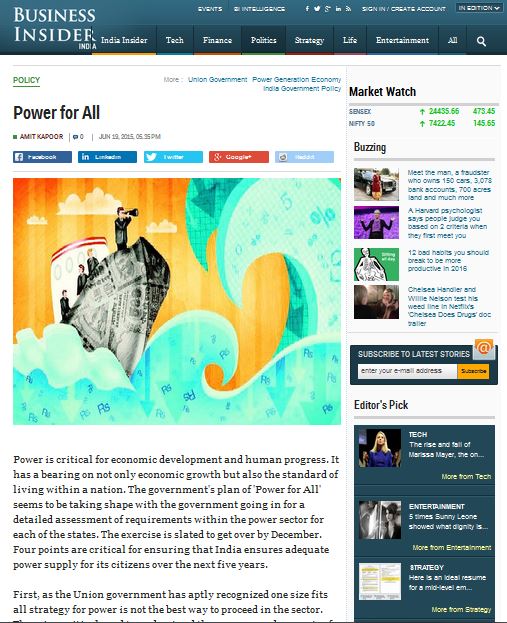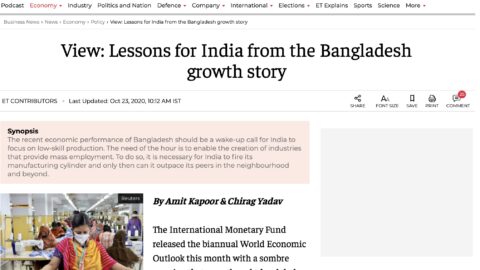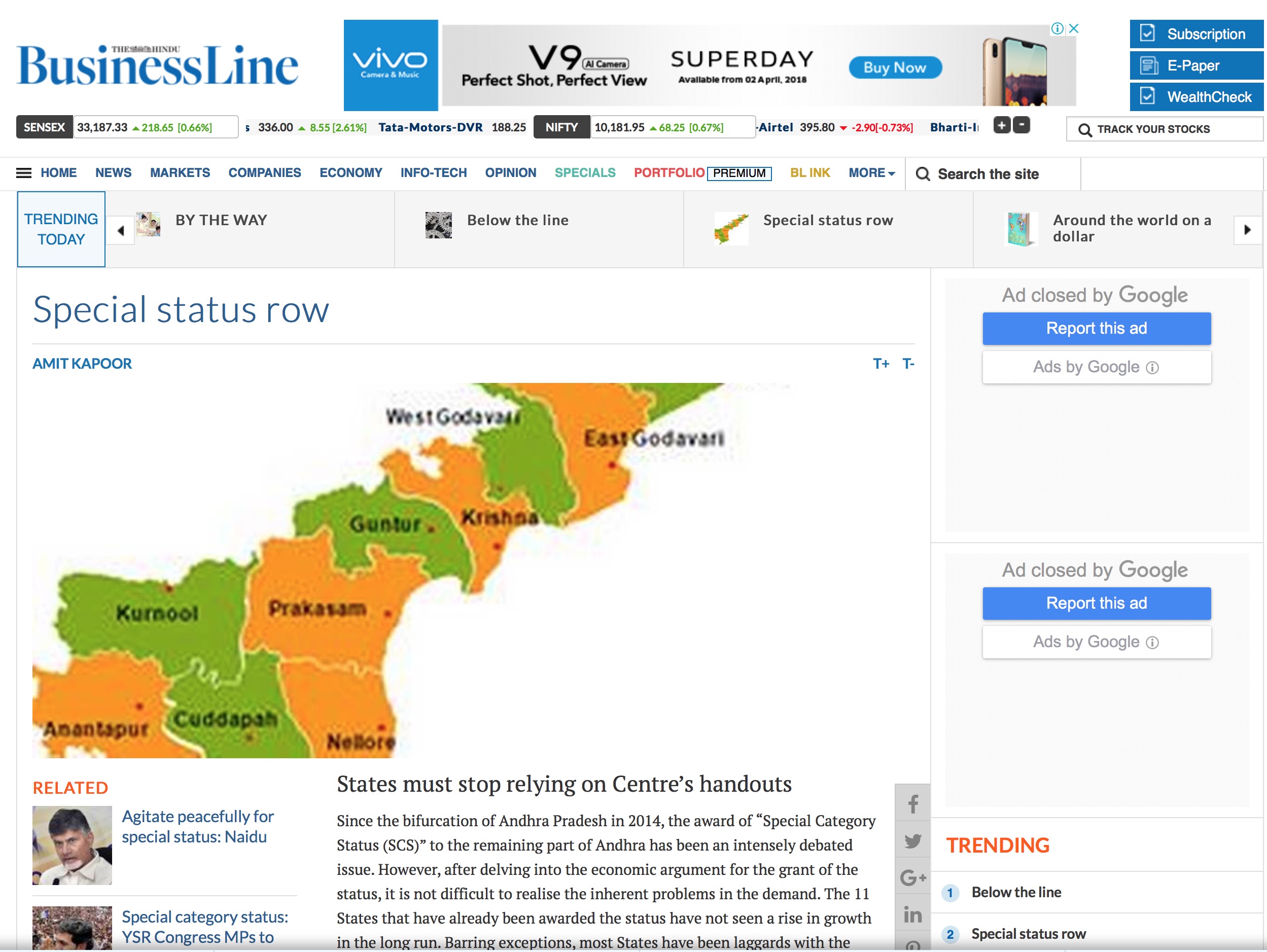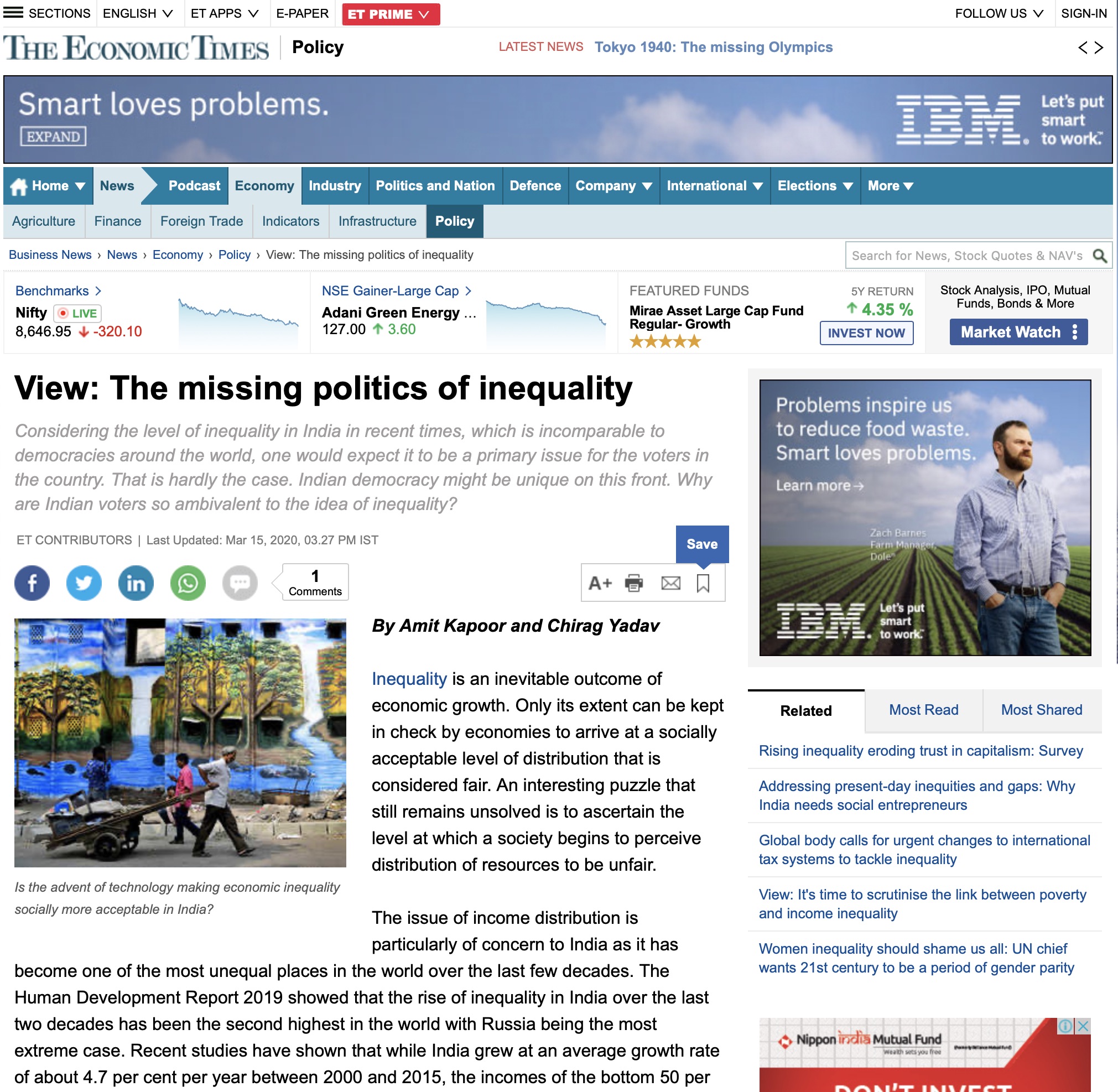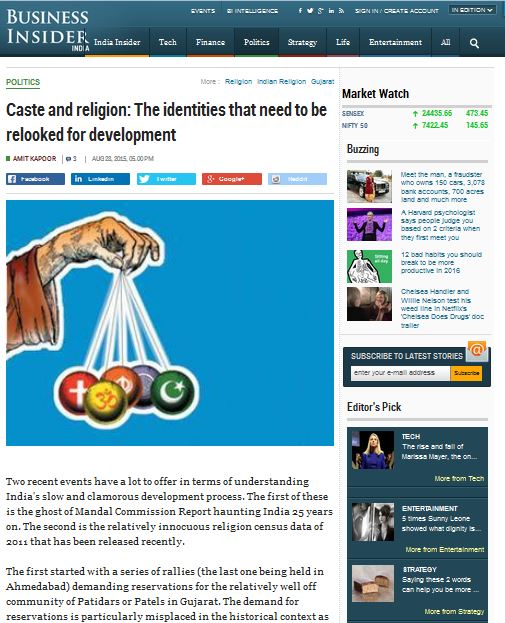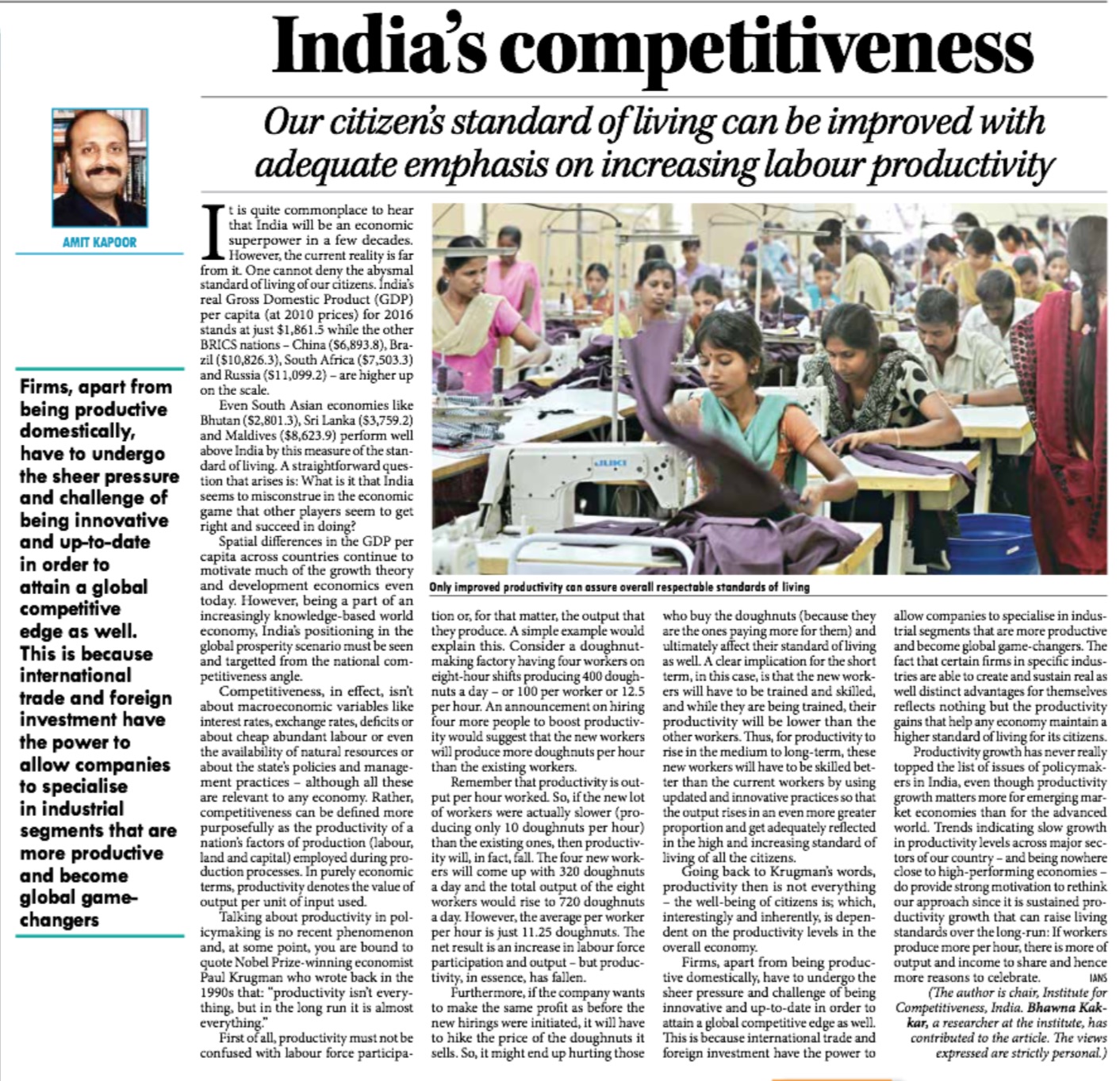By Bibek Debroy, Amit Kapoor & Aditya Sinha
In the heart of Bengaluru, once celebrated as the City of Lakes, an unfolding drama of scarcity paints a stark contrast against its historic abundance. Where waters once flowed freely, nurturing life and livelihoods, now the taps run dry, heralding a dire daily struggle for survival. Residents, pushed to the brink, have adapted to a life of stringent water rationing—showers a rare luxury, cooking a water-intensive indulgence foregone, and reliance on treated water for basic needs becoming the norm. The city’s dependency on erratic water tanker deliveries exacerbates the crisis, with demand far outstripping supply, leaving communities grappling with the harsh realities of scarcity. This highlights a more widespread phenomenon of urban water crises unfolding globally.
A study published in Nature reveals that urbanization and climate change are jointly intensifying the issue of water scarcity, where the demand for water surpasses its availability across the globe’s cities. By quantifying the global urban water scarcity for the years 2016 and 2050 across four different socioeconomic and climate scenarios and investigating possible interventions, the study forecasts a significant rise in the urban population grappling with water scarcity—from 933 million, which is a third of the global urban populace in 2016, to an estimated 1.693 to 2.373 billion, accounting for a third to nearly half of the global urban population by 2050. India is expected to bear the brunt of this increase, with an anticipated surge in its water-scarce urban population by 153 to 422 million people. Additionally, the number of large cities facing water scarcity is predicted to expand from 193 to between 193 and 284, including between 10 to 20 megacities.
In 2018, NITI Aayog developed a Composite Water Management Index, revealing significant disparities in water resource management across Indian states. The analysis for the fiscal year 2016-17 showed that while Gujarat led with a score of approximately 76, Meghalaya lagged at around 26, with most states scoring below 50 and thus highlighting the need for substantial improvements in their water management practices. The report categorized states into high, medium, and low performers based on their scores, indicating that water-scarce states like Gujarat, Madhya Pradesh, and Andhra Pradesh were among the high performers, likely driven by the urgency of addressing water shortages. Conversely, states with lower performance, housing around 50% of India’s population, face significant water management challenges that could pose risks to the country’s food security due to declining groundwater levels and inadequate policy actions.
In India, water is a state subject. This means that the primary responsibility for augmentation, conserving, and managing water resources efficiently lies with the state governments. The union government supports these efforts by offering both technical and financial aid to the states via a range of schemes and initiatives.
Addressing the urban water crisis in India requires a sophisticated, integrated approach. India’s unique challenges—ranging from geographic and climatic diversity to socio-economic disparities—demand solutions that are as innovative as they are inclusive. Below, we delve into a technically rich and context-specific exploration of how institutional strengthening, advanced information management, and innovative infrastructure development can form the pillars of sustainable urban water management in India.
The foundation of water security in India must be built upon robust legal and regulatory frameworks that are both flexible and enforceable. Adaptive management principles, akin to those in the Australian Water Act but tailored to India’s context, can ensure dynamic allocation systems that adjust allocations based on real-time data and monsoon patterns. Implementing a nationwide framework for water rights and trading, facilitated by blockchain technology, could provide a transparent, efficient mechanism for managing water allocations across states, considering India’s inter-state river disputes.
Introducing progressive water pricing mechanisms, reflecting the true scarcity value of water and its externalities, could promote conservation and efficient use across urban India. Digital technologies can support variable pricing models, adjusting rates based on availability, demand, and user behavior. Additionally, incentives for adopting water-saving technologies and practices, underpinned by digital platforms, can drive behavioral change among industries, agriculture, and domestic users, making water conservation rewarding and trackable.
Deploying IoT sensors across India’s urban water infrastructure can offer real-time insights into water quality, distribution inefficiencies, and leakage. Coupled with AI and big data analytics, this data can guide predictive maintenance, optimize distribution, and enhance water quality management. For example, Bengaluru’s water utility could use such technologies to address its significant leakage issues, potentially recovering millions of liters of water daily.
Leveraging India’s prowess in space technology and remote sensing, through institutions like ISRO, for advanced hydro-meteorological forecasting can transform water management. Integrating satellite data with ground-based observations and AI models can provide accurate, real-time forecasts for precipitation, evapotranspiration, and potential flooding, crucial for water-sensitive urban planning and agricultural water management.
Investing in nanotechnology for water purification and desalination can offer scalable solutions to India’s clean water challenges. Graphene-based filters, for instance, could revolutionize water purification efforts, making it more efficient and less energy-intensive, particularly in coastal cities facing freshwater scarcity.
Adopting advanced engineered systems for stormwater capture and wastewater reuse in urban areas can significantly augment India’s water resources. Techniques such as Managed Aquifer Recharge (MAR), particularly relevant in the over-exploited groundwater zones of Punjab, Haryana, and Rajasthan, can be a game-changer. Implementing green infrastructure projects, like rain gardens and permeable pavements in cities such as Chennai or Mumbai, can enhance groundwater recharge and reduce urban flooding.
The rapid dissemination and localization of these technologies and practices are key to India’s water security. Initiatives like the Smart Cities Mission provide a platform for integrating these innovations into urban planning and management. International collaboration, through platforms like the World Bank and United Nations, coupled with public-private partnerships, can accelerate the adoption of best practices and technologies tailored to India’s needs.
Sewage Treatment Plants (STPs) in many cities across India primarily focus on treating wastewater to a level where it can be discharged into water bodies without causing environmental harm, rather than purifying it to potable standards. This approach stems from various factors, including technological limitations, financial constraints, and regulatory frameworks that don’t mandate the upgrading of STPs to produce drinking-quality water. The treated water from most STPs in India is often used for irrigation, industrial cooling, or landscaping, rather than for human consumption.
To transform STP treated water into a potable resource and address water scarcity, a multifaceted strategy encompassing infrastructure upgrades, regulatory enhancements, public education, financial investment, and holistic water management is essential. The introduction of advanced treatment technologies within STPs is crucial for eliminating diverse contaminants to ensure water safety. Simultaneously, stricter regulations and guidelines for water quality and reuse, including direct potable reuse, must be established and enforced to compel STP upgrades for producing drinkable water. Additionally, altering public perceptions through awareness and education about the safety and advantages of using recycled wastewater is key to increasing acceptance of such practices. This endeavor also demands substantial investments to modernize existing STPs and construct new facilities with cutting-edge treatment capabilities, achievable through public-private partnerships and government support.
The Union Government has taken several strategic measures to address the critical issue of water scarcity, recognizing the challenges posed by the decreasing per capita water availability due to population growth and the variable monsoon patterns that affect water distribution across regions. One significant initiative is the “Jal Shakti Abhiyan: Catch the Rain” (JSA:CTR), launched by the Prime Minister on World Water Day, March 22, 2021. This nationwide campaign aimed to enhance rainwater harvesting and water conservation across all districts, involving activities such as the enumeration and geo-tagging of water bodies, setting up Jal Shakti Kendras, intensive afforestation, and raising public awareness about conserving water.
Further, the government’s commitment to mitigating water crisis encompasses long-term strategic plans such as the National Perspective Plan for interlinking rivers, aimed at transferring water from surplus to deficit regions, and the Jal Jeevan Mission (JJM) targeting universal access to potable tap water in by 2024. Other notable programs include AMRUT 2.0 for universal water supply in urban areas, Pradhan Mantri Krishi Sinchayee Yojana (PMKSY) for improving irrigation and water efficiency in agriculture, and the ‘Sahi Fasal’ campaign to encourage the cultivation of water-efficient crops. The Atal Bhujal Yojana emphasizes community participation for groundwater management in water-stressed areas, demonstrating a multi-faceted approach to ensuring sustainable water use and management in the face of growing demands and climatic uncertainties.
In confronting the urban water crisis, India’s strategy necessitates the seamless integration of advanced technological frameworks and community-based innovation with its overarching water management policies. The deployment of decentralized green infrastructure, facilitated by Geographic Information System (GIS) and Remote Sensing (RS) technologies, aims to optimize urban groundwater recharge and manage runoff. Simultaneously, the use of Internet of Things (IoT) and artificial intelligence (AI) for smart water metering and predictive analytics can significantly enhance water use efficiency and system resilience. Expanding public-private partnerships to include tech startups and NGOs will accelerate the adoption of cutting-edge water conservation and recycling technologies. Further, the promotion of research in nanotechnology and advanced materials for water purification and desalination seeks to scale up solutions for safe drinking water. Embedding STEM principles focused on water sustainability in educational curriculums is crucial for fostering a culture of water stewardship. This comprehensive approach, combining technological innovations, participatory governance, and educational initiatives, underpins India’s efforts to build a resilient urban water management framework capable of addressing the multifaceted challenges of water scarcity and ensuring a sustainable water future.
Bibek Debroy is Chairman, Economic Advisory Council to the Prime Minister (EAC-PM), Amit Kapoor is Chair, Institute for Competitiveness & Aditya Sinha is OSD, Research, EAC-PM.
The article was published with Business World on March 26, 2024.

